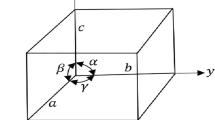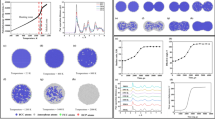Abstract
In this paper we present a modeling approach to bridge the atomistic with macroscopic scales in crystalline materials. The methodology combines identification and modeling of the controlling unit processes at microscopic level with the direct atomistic determination of fundamental material properties. These properties are computed using a many body Force Field derived from ab initio quantum-mechanical calculations. This approach is exercised to describe the mechanical response of high-purity Tantalum single crystals, including the effect of temperature and strain-rate on the hardening rate. The resulting atomistically informed model is found to capture salient features of the behavior of these crystals such as: the dependence of the initial yield point on temperature and strain rate; the presence of a marked stage I of easy glide, specially at low temperatures and high strain rates; the sharp onset of stage II hardening and its tendency to shift towards lower strains, and eventually disappear, as the temperature increases or the strain rate decreases; the parabolic stage II hardening at low strain rates or high temperatures; the stage II softening at high strain rates or low temperatures; the trend towards saturation at high strains; the temperature and strain-rate dependence of the saturation stress; and the orientation dependence of the hardening rate.
Similar content being viewed by others
References
V.V. Bulatov and L.P. Kubin. Dislocation modelling at atomistic and mesoscopic scales. Current Opinion in Solid State & Materials Science, 3(6):558-561, 1998.
R. Phillips. Multiscale modeling in the mechanics of materials. Current Opinion in Solid State & Materials Science, 3(6):526-532, 1998.
G.H. Campbell, S.M. Foiles, H.C. Huang, D.A. Hughes, W.E. King, D.H. Lassila, D.J. Nikkel, T.D. de la Rubia, J.Y. Shu, and V.P. Smyshlyaev. Multi-scale modeling of polycrystal plasticity: a workshop report. Materials Science and Engineering A-Structural Materials Properties Microstructure and Processing, 251(1-2):1-22, 1998.
R. Phillips, D. Rodney, V. Shenoy, E. Tadmor, and M. Ortiz. Hierarchical models of plasticity: dislocation nucleation and interaction. Modelling and Simulation in Materials Science and Engineering, 7(5):769-780, 1999.
J.A. Moriarty, W. Xu, P. Soderlind, J. Belak, L.H. Yang, and J. Zhu. Atomistic simulations for multiscale modeling in bcc metals. Journal of Engineering Materials and Technology-Transactions of the ASME, 121(2):120-125, 1999.
M.I. Baskes. The status role of modeling and simulation in materials science and engineering. Current Opinion in Solid State & Materials Science, 4(3):273-277, 1999.
M. Ortiz, E.A. Repetto, and L. Stainier. A theory of subgrain dislocation structures. Journal of theMechanics and Physics of Solids, 48(10):2077-2114, 2000.
M. Ortiz and E.A. Repetto. Nonconvex energy minimization and dislocation structures in ductile single crystals. Journal of the Mechanics and Physics of Solids, 47(2):397-462, 1999.
L. Stainer, A.M. Cuitiño, and M. Ortiz. Micromechanical modeling of hardening, rate sensitivity and thermal softening in bcc single crystals. Journal of the Mechanics and Physics of Solids, 2001.
Duesbery, V. Vitek, and Bowen. Proceedings of the Royal Society of London, A332:85, 1973.
V. Vitek. Proceedings of the Royal Society of London, A352:109, 1976.
V. Vitek. Structure of dislocation cores in metallic materials and its impact on their plastic behavior. Progress in Material Science, 36:1-27, 1992.
W. Xu and J.A. Moriarty. Atomistic simulation of ideal shear strength, point defects, and screw dislocations in bcc transition metals:Mo as a prototype. Physical Review B-Condensed Matter, 54(10):6941-6951, 1996.
M.S. Duesbery and V. Vitek. Plastic anisotropy in bcc transition metals. Acta Materialia, 46(5):1481-1492, 1998.
S. Ismail-Beigi and T.A. Arias. Ab initio study of screw dislocations in mo and ta: A new picture of plasticity in bcc transition metals. Physical Review Letters, 84(7):1499-1502, 2000.
G. Wang, A. Strachan, T. Cagin, and W.A. III Goddard. Molecular dynamics simulations of \( \frac{1}{2} \) a< 111 > screw dislocation in ta. Materials Science and Engineering A-Structural Materials Properties Microstructure and Processing, 309(SI):133-137, 2001.
M.S. Duesbery and W. Xu. The motion of edge dislocations in body-centered cubic metals. Scripta Materialia, 39(3):283-287, 1998.
P. B. Hirsch. In 5th International Conference on Crystallography, page 139. Cambridge University, 1960.
A. Seeger and P. Schiller. Acta Metallurgica, 10:348, 1962.
J. P. Hirth and J. Lothe. Theory of Dislocations. McGraw-Hill, New York, 1968.
J.P. Hirth and R.G. Hoagland. Nonlinearities in the static energetics and in the kinematics of dislocations. Physica D, 66(1-2):71-77, 1993.
W. Xu and J.A. Moriarty. Accurate atomistic simulations of the peierls barrier and kink-pair formation energy for < 111 > screw dislocations in bcc mo. Computational Materials Science, 9(3-4):348-356, 1998.
A. Seeger and L. Hollang. The flow-stress asymmetry of ultra-pure molybdenum single crystals. Materials Transactions JIM, 41(1):141-151, 2000.
W. Wasserbäch. Philosophical Magazine, A53:335, 1986.
R. Lachenmann and H. Schultz. Scripta Metallurgica, 4:33, 1970.
M. Tang, B. Devincre, and L.P. Kubin. Simulation and modelling of forest hardening in body centre cubic crystals at low temperature. Modelling and Simulation in Materials Science and Engineering, 7(5):893-908, 1999.
T. Suzuki, S. Takeuchi, and H. Yoshinaga. Dislocation Dynamics and Plasticity. Springer-Verlag, 1991.
A.D. Brailsford. Electronic component of dislocation drag in metals. Physical Review, 186:959-961, 1969.
M.I. Baskes, R.G. Hoagland, and T. Tsuji. An atomistic study of the strength of an extended-dislocation barrier. Modelling and Simulation in Materials Science and Engineering, 6(1):9-18, 1998.
D. Rodney and R. Phillips. Structure and strength of dislocation junctions: An atomic level analysis. Physical Review Letters, 82(8):1704-1707, 1999.
V.B. Shenoy, R.V. Kukta, and R. Phillips. Mesoscopic analysis of structure and strength of dislocation junctions in fcc metals. Physical Review Letters, 84(7):1491-1494, 2000.
G. Danna and W. Benoit. Dynamic recovery of the microstructure of screw dislocations in high-purity bcc metals. Materials Science and Engineering A-Structural Materials Properties Microstructure and Processing, 164(1-2):191-195, 1993.
M. Rhee, H.M. Zbib, J.P. Hirth, H. Huang, and T. de la Rubia. Models for long-/short-range interactions and cross slip in 3d dislocation simulation of bcc single crystals. Modelling and Simulation in Materials Science and Engineering, 6(4):467-492, 1998.
H.C. Huang, N. Ghoniem, T.D. de la Rubia, M. Rhee, H. Zbib, and J. Hirth. Stability of dislocation shortrange reactions in bcc crystals. Journal of Engineering Materials and Technology-Transactions of the ASME, 121(2):143-150, 1999.
L. P. Kubin, B. Devincre, and M. Tang. Journal of Computer Aided Material Design, 5:31, 1998.
H.M. Zbib, T.D. de la Rubia, M. Rhee, and J.P. Hirth. 3d dislocation dynamics: stress-strain behavior and hardening mechanisms in fcc and bcc metals. Journal of Nuclear Materials, 276:154-165, 2000.
P. Franciosi and A. Zaoui. Multislip in f.c.c. crystals: A theoretical approach compared with experimental data. Acta Metallurgica, 30:1627, 1982.
P. Franciosi and A. Zaoui. Glide mechanisms in b.c.c. crystals: an investigation of the case of α-iron through multislip and latent hardening tests. Acta Metallurgica, 31:1331, 1983.
D. Kuhlmann-Wilsdorf. Theory of plastic deformation: properties of low energy dislocation structures. Materials Science and Engineering, A113:1, 1989.
W. G. Johnston and J. J. Gilman. Dislocation velocities, dislocation densities and plastic flow in lithium fluoride crystals. Journal of Applied Physics, 30:129, 1959.
W. G. Johnston and J. J. Gilman. Dislocation multiplication in lithium fluoride crystals. Journal of Applied Physics, 31:632, 1960.
P. P. Gillis and J. Gilman. Dynamical Dislocation Theory of Crystal Plasticity. II. Easy Glide and Strain Hardening. Journal of Applied Physics, 36:3380, 1965.
U. Essmann and M. Rapp. Slip in copper crystals following weak neutron bombardment. Acta Metallurgica, 21:1305, 1973.
K.P.D. Lagerlof. On deformation twinning in bcc metals. Acta Metallurgica et Materialia, 41(7):2143-2151, 1993.
H. Dybiec. Model of the early deformation stage of bcc metals in low-temperature. Zeitschrift für Metallkunde, 86(7):512-517, 1995.
A. Strachan, T. Cagin, O. Gulseren, S. Mukherjee, R.E. Cohen, and W.A. Goddard III. First principles force field for metallic tantalum. Physical Review B, 2001.
M.S. Daw and M.I. Baskes. Embedded-atom method-derivation and application to impurities, surfaces, and other defects in metals. Physical Review B-Condensed Matter, 29(12):6443-6453, 1984.
M.S. Daw, S.M. Foiles, and M.I. Baskes. The embedded-atom method-a review of theory and applications. Materials Science Reports, 9(7-8):251-310, 1993.
S. Chantasiriwan and F. Milstein. Higher-order elasticity of cubic metals in the embedded-atom method. Physical Review B-Condensed Matter, 53(21):14080-14088, 1996.
P. Vinet, J.H. Rose, J. Ferrante, and J.R. Smith. Universal features of the equation of state of solids. Journal of Physics-Condensed Matter, 1(11):1941-1963, 1989.
P. Vinet, J. Ferrante, J.R. Smith, and J.H. Rose. A universal equation of state for solids. Journal of Physics C-Solid State Physics, 19(20):L467-L473, 1986.
Tahir Cagin Alejandro Strachan and William A. Goddard III. Critical behavior in spallation failure of metals. Physical Review B, 63:0601034, 2001.
G. Wang, A. Strachan, T. Cagin, and W.A. Goddard III. Kinks in a/2 < 111> screw dislocation in ta. Journal of Computer Aided Materials Design, 2001.
L.H. Yang, P. Soderlind, and J.A. Moriarty. Accurate atomistic simulation of (a/2) < 111 > screw dislocations and other defects in bcc tantalum. Philosophical Magazine A-Physics of Condensed Matter Structure Defects and Mechanical Properties, 81(5):1355-1385, 2001.
T.E. Mitchell and W.A. Spitzig. Three-stage hardening in tantalum single crystals. Acta Metallurgica, 13:1169-1179, 1965.
M. Ortiz and L. Stainier. The variational formulation of viscoplastic constitutive updates. Computer Methods in Applied Mechanics and Engineering, 171(3-4):419-444, 1999.
Author information
Authors and Affiliations
Rights and permissions
About this article
Cite this article
Cuitiño, A.M., Stainier, L., Wang, G. et al. A multiscale approach for modeling crystalline solids. Journal of Computer-Aided Materials Design 8, 127–149 (2001). https://doi.org/10.1023/A:1020012431230
Issue Date:
DOI: https://doi.org/10.1023/A:1020012431230




